If you’re looking for a way to store dehydrated food, mason jars are an excellent option. Also known as canning jars, these jars are airtight and sturdy, making them perfect for keeping your food fresh and safe. In this article, we’ll cover everything you need to know about how to store dehydrated food in mason jars. The simple solution to storing dried food = Mason Jars!

First, we’ll explain what dehydrated food is and how it differs from other types of food. Then, we’ll discuss how to choose the right type of mason jar for your needs and how to prepare the jars for storage. We’ll also walk you through the process of how to store your dehydrated food in mason jars and offer some tips for long-term storage. Finally, we’ll cover some alternative storage options and address some frequently asked questions about how to store dehydrated food in mason jars.
Key Takeaways
- Mason jars are a great option for storing dehydrated food due to their airtight, sturdy design.
- To store dehydrated food in mason jars, choose the right jar size, prepare the jars properly and store in a cool, dry place.
- With proper storage techniques, dehydrated food can last for months or even years in mason jars.
- Key Takeaways
- Quick Steps of How to Store Dehydrated Food in Mason Jars
- Understanding Dehydrated Food
- What are the Different Names of Mason Jars?
- Choosing the Right Mason Jars
- How to Sterilize Mason Jars for Dry Food Storage
- The Process of Storing Dehydrated Food in Mason Jars
- Alternative Dehydrated Food Storage Container Options
- Where to Store Dehydrated Food in Mason Jars
- How Long Does Dehydrated Food Last in Mason Jars?
- Vacuum Sealing Dry Food in Mason Jars
- Oxygen Absorbers vs. Moisture Absorbers in Mason Jars
- Storing Different Types of Dehydrated Foods
- Advantages and Disadvantages of Using Mason Jars
- Best Glass Jars for Dried Food Storage
- Tips for Long Term Storage of Dehydrated Food in Mason Jars
- Dealing with Potential Issues
- Frequently Asked Questions
- Sources
Quick Steps of How to Store Dehydrated Food in Mason Jars
- Clean and dry the mason jars
- Dehydrate the food
- Condition the food for long term storage
- Add oxygen absorber (optional)
- Vacuum seal the jar for long term storage
- Store the jar in a cool, dark, dry place
Boom! You’re an expert now, right? Not quite! Read on to learn some Pro Tips about how to best store dehydrated food in mason jars.
Understanding Dehydrated Food
If you’re looking to store food for a long time, dehydrating your food is a great option. Dehydrated food is essentially food that has had almost all the moisture removed from it. This makes it lightweight, easy to store and it has a long shelf life. In fact, some dehydrated food can last for years if stored properly.
To go from Zero to Dehydrating Pro, check out our expert tips and tricks to dehydrating food in Dehydrating 101: How a Food Dehydrator Works!
How Dehydrating Food Works
Dehydrating food is a simple process that involves removing moisture from food using heat and air. This can be done using a dehydrator, air fryer, solar dryer or even your oven on low temperatures. The process of dehydrating food can take anywhere from a few hours in a dehydrator to a few days in a solar dryer. Dehydrating times depending on the type of food and the drying method used.
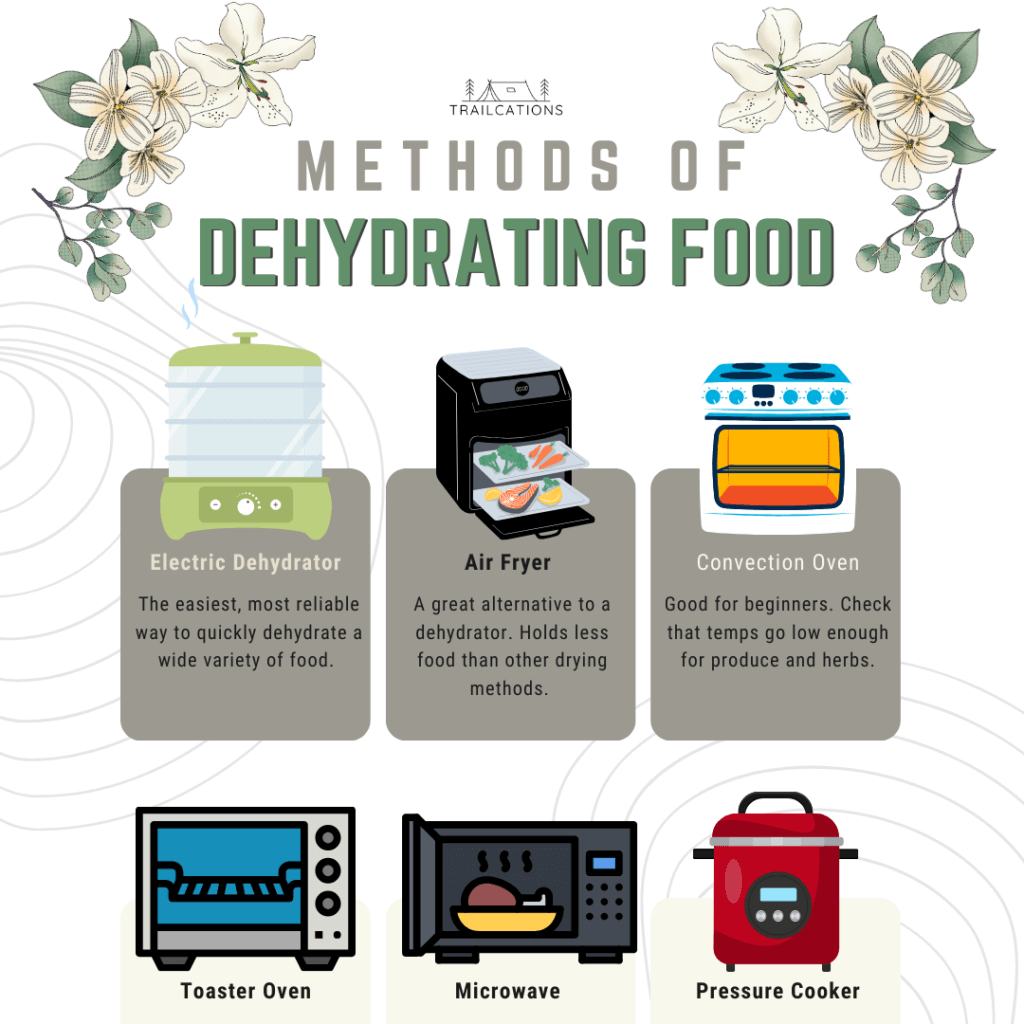
Did you know you can dehydrate food in the microwave? Yep, you betcha!
Check out our article on 15 Methods of Dehydrating Food at Home to learn about the different ways you can dry your own food (and save money!).
Nutrient Content of Dehydrated Food
One thing to keep in mind is that dehydrating can affect the nutritional content of the food. A few vitamins and minerals are naturally lost during the dehydration process. However, dehydrating preserves a whopping 95-97% of nutrients compared to canning (only 20-40% preserved) and freezing (40-60% nutrients preserved) [1]. Dehydrating can still be a great source of nutrients, especially if it’s done properly.
Not entirely convinced if dehydrating food is healthy? We did a bunch of research into the history and health of home dried food. Check out our article on dehydrated food nutrient pros and cons in “Debunking the Myth: Is Dehydrated Food Healthy?”
Dehydrated Food Storage
When storing dehydrated food, it’s important to keep it in an airtight container to prevent moisture, oxygen and bacteria from getting in. Mason jars are a great option for storing dehydrated food. They are airtight, can be vacuum sealed and are hard sided to deter pests.
Pro Tip: Make sure to label mason jars with the contents and the date they were dehydrated. After a while, dehydrated food all starts to look the same!
What are the Different Names of Mason Jars?
Did you know that Mason jars are a genericized trademarked name for what is commonly known as a canning jar or fruit jar? These types of jars are typically used in home canning to preserve food but are also excellent options for storing dehydrated food.
Did you know? Genericized trademarked names are brand names that have become so popular they’ve become the generic name for a product or service. Examples are: aspirin, trampolines, video tapes, app store, escalators, zippers, Taco Tuesday (our personal favorite) and mason jars.
The Mason jar is named after an American tinsmith John Landis Mason who invented and patented the iconic screw top jar in 1858. After losing the patent for the jar, other companies started manufacturing their versions of the mason jar. Other common names for mason jars include jam jars, glass canning jars, fruit jars, preserve jars, Ball jars (named for the Ball Corporation) or Kerr jars (made by the Kerr Glass Manufacturing Company).
All of these types of jars consist of tempered glass that withstands high temperatures of canning. They have a screw top lid, which when tightened down presses a rubber seal against the glass rim of the lid. This forms an airtight seal making mason jars perfect for storing dehydrated food and dry goods.
Choosing the Right Mason Jars
When it comes to storing dehydrated food, choosing the right mason jar is crucial. Mason jars are a popular choice because they are durable, airtight and come in a variety of sizes. However, not all mason jars are created equal and it’s important to choose the right one for your needs.
Glass Jars vs. Canning Jars
First, it’s important to understand the difference between glass jars and canning jars. Glass jars are typically thinner and more fragile than canning jars, which are designed to withstand the high heat and pressure of the canning process. While glass jars can be used for storing dehydrated food, canning jars are generally a better choice because they are more durable and less likely to break or crack.
Size Matters (for Storing Dehydrated Food in Mason Jars!)
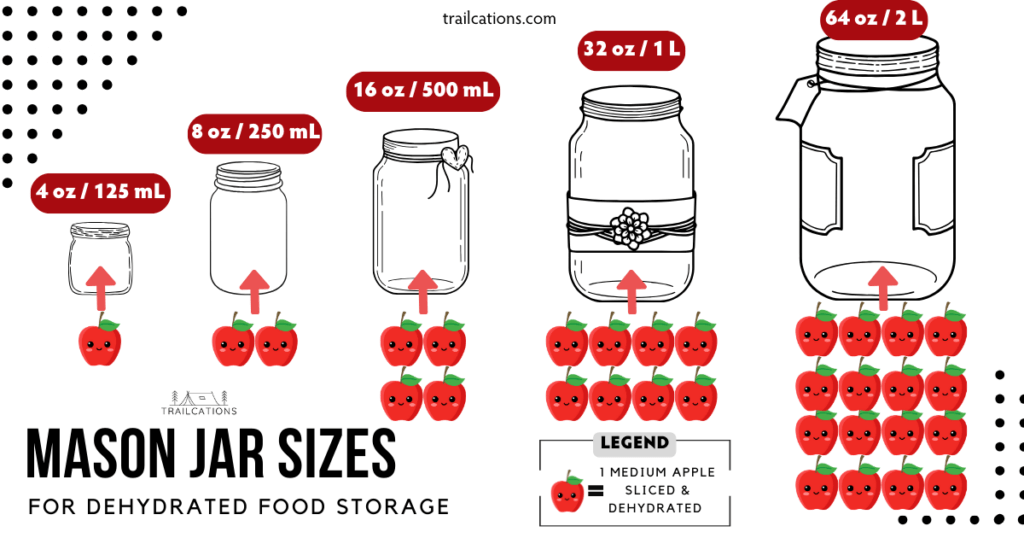
When choosing a mason jar for storing dried food, size matters. You want to choose a jar that is just the right size for the amount of food you are storing. If the jar is too large, there will be too much air inside, which can cause the food to spoil. If the jar is too small, the food may not fit properly, which can also lead to spoilage. Take an extra moment to choose the right size mason jars for the amount of dehydrated food on hand.
Some popular sizes of mason jars for storing dehydrated food include:
- quarter pint (4oz or 125 mL)
- half-pint (8 oz or 250 mL)
- pint (16 oz or 500 mL)
- quart (32 oz or 1 L)
- half-gallon (64 oz or 2 L)
Sealing and Lid Options
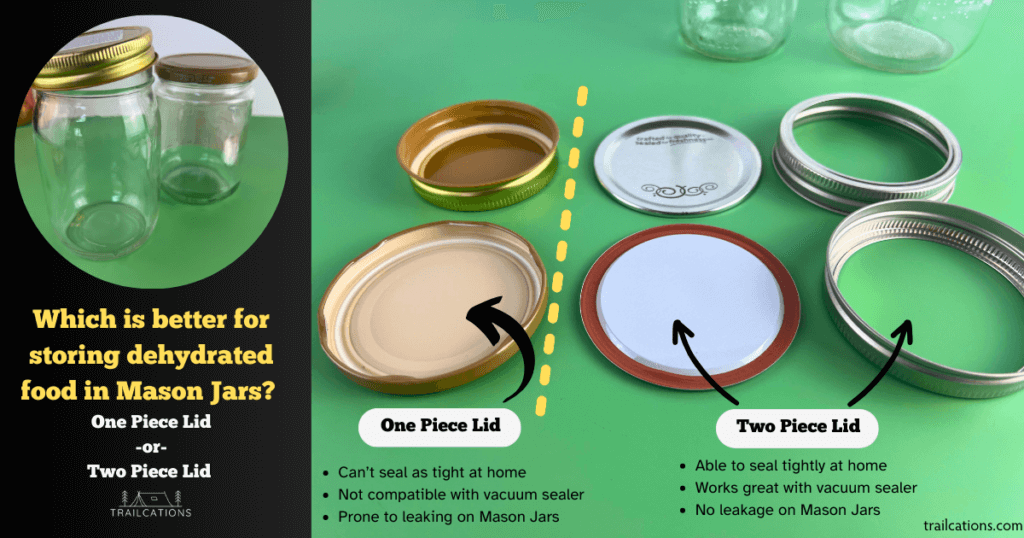
Another important factor to consider when choosing a mason jar is the sealing and lid options. You want to choose a jar that has a tight-fitting lid that is easy to seal. Some mason jars come with a two-piece lid that includes a flat metal disc and a screw-on band. Other jars have a one-piece lid that is made of plastic or glass. Both options work well, but the two-piece lid is generally considered to be more airtight. Keep in mind that some vacuum sealers only work with two-piece lids.
Regular-Mouth vs. Wide-Mouth Jars
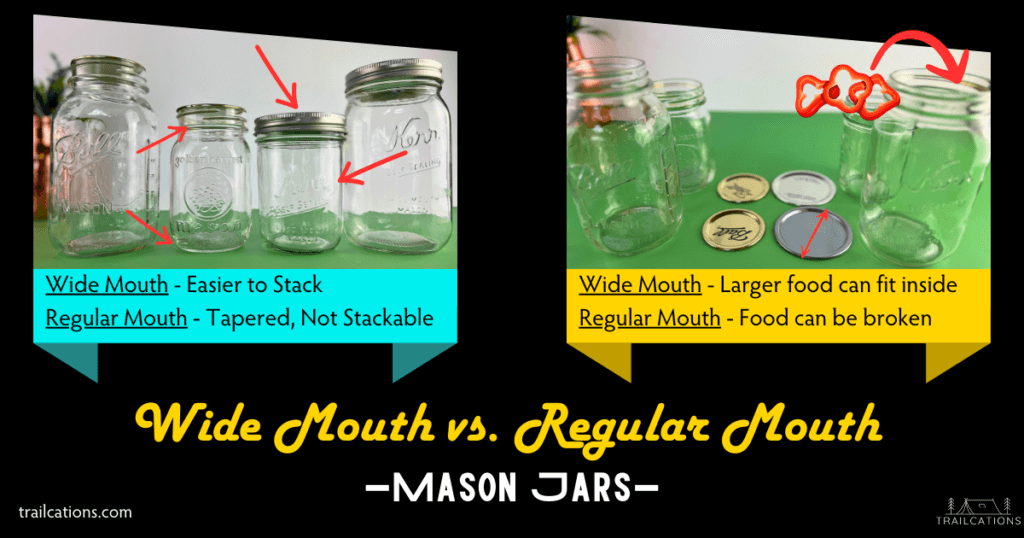
There are two basic types of mason jars: the tapered regular-mouth jar and the cylindrical wide-mouth jar. Both types of canning jars have their pros and cons.
Regular-Mouthed Jars: Regular-mouthed jars are tapered at the top and bottom and have a smaller lid diameter. It can be difficult to store larger dehydrated items in these. You may have to break or smash bigger dehydrated foods like citrus slices, peppers and tomato slices.
Wide-Mouthed Jars: Wide-mouthed jars can hold larger food pieces than regular-mouth jars as the container sides are straight the whole way through. Larger foods can also fit inside the wide lid easier. Wide-mouth jars can be stacked easier than the tapered regular-mouthed jars which is important if you have a lot of dehydrated food to store in your pantry.
What We Prefer: We typically use wide-mouthed jars because they fit larger food pieces and are easier to stack. However, most vacuum seal attachments today come with adapters to fit both diameter jars.
What Mason Jar Should You Choose for Storing Dehydrated Food?
In conclusion, choosing the right mason jar is essential for storing dehydrated food. When selecting a jar, consider the size, durability and sealing options. Canning jars are generally the best choice, but glass jars can also be used. Whatever you choose, make sure it has a tight-fitting lid that is easy to seal to keep your dehydrated food fresh and tasty.
How to Sterilize Mason Jars for Dry Food Storage
When it comes to storing dehydrated food, mason jars are a great option. However, before you start storing your food, you need to prepare the jars properly. Here are some steps to follow to make sure your jars are ready for storage:
Sterilize the Jars
Before you use your mason jars for storage, it’s important to sterilize them. This will help to prevent any bacteria or mold from growing on your food. To sterilize your jars, you can either run them through a dishwasher cycle or boil them in water for 10 minutes. Make sure to let the jars dry and cool completely before you use them for dehydrated food storage.
Use Canning Lids
When you’re storing dehydrated food in mason jars, it’s best to use the two-piece canning lids. Regular lids won’t create an airtight seal, which can allow air and moisture to get in and spoil your food. Canning lids are designed to create a tight seal that will keep your food fresh for longer. They also are compatible with vacuum sealer attachments to increase the shelf life and longevity of your dried food.
Clean and Dry the Lids
Before you use your canning lids, make sure to thoroughly clean and dry them. You can run the two-piece canning jar lids in the dishwasher or hand wash them. The important part is to ensure that the lids are extremely dry as any excess moisture can cause your dehydrated food to spoil.
Fill the Jars
When you’re ready to fill your jars with dehydrated food, pack it in tightly. Use the right sized jar for the amount of dehydrated food on hand. Too much space in the jar means that nutrient-destroying oxygen can decrease the shelf life of your dried food.
It’s also important to make sure the food is completely dry before you put it in the jars. Any moisture can cause the food to spoil.
By following these simple steps, you can ensure that your mason jars are properly prepared for storing dehydrated food. With the right preparation, you can enjoy your dehydrated food for months or even years to come.
The Process of Storing Dehydrated Food in Mason Jars
If you want to learn how to store dehydrated food in mason jars, you need to follow a few simple steps to ensure that the food stays fresh and safe to eat for a long time. Here’s how you can do it:
Step 1: Clean and Dry the Mason Jars
Before you start storing the dehydrated food in mason jars, you need to make sure that the jars are clean and free from any dirt or bacteria. Wash the jars and lids in hot, soapy water to kill off bad bacteria, mold and yeasts. Most mason jars and lids can be cleaned in the dishwasher. Most importantly, ensure that the jars and lids are completely dry before using. Any excess moisture will shorten the shelf life and potentially spoil the dehydrated food inside.
Step 2: Dehydrate the Food
The next step is to prepare the dehydrated food for storage. Ensure that it is completely dry and free from moisture by using one of the doneness tests.
Let the dehydrated food cool for 30 to 60 minutes before placing it inside the mason jar. We like to roll up the drying tray inserts or nonstick mesh inserts into a funnel shape to make it easier to pour food into the mason jar. You can store any fat-free and oil-free food inside the canning jar like dried spices, herbs, mushrooms, grains, veggies and dried fruits.
Step 3: Condition the Food for Long Term Storage
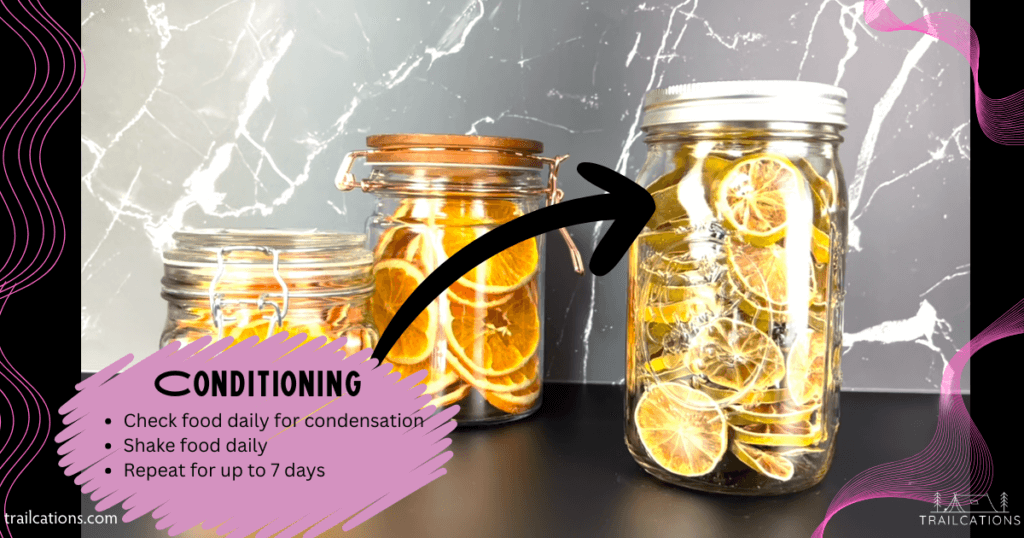
Conditioning equalizes the moisture levels in individual pieces of food and is an important quality check to ensure your dehydrated food is completely dry. Once the food is cool, pack it into the clean, dry canning jars and screw on the lid tightly. You can vacuum seal the jar at this point if you’d like.
Condition fruits and vegetables by placing them in clear mason jars for 3 to 7 days, checking for moisture daily. If moisture appears as condensation on the side of the jar, immediately return the entire batch of food to the dehydrator for a few hours. It is heartbreaking to put “dried” food in storage only to find out that it molded a couple months later.
Step 4: Add Oxygen Absorber (Optional)
You can add an oxygen absorber to the jar before sealing long term it if you want to extend the shelf life of the food. The oxygen absorber will remove any residual oxygen from the jar, which can help prevent the growth of bacteria and mold. However, adding an oxygen absorber isn’t necessary, especially if you vacuum seal the jars to remove oxygen.
Step 5: Vacuum Seal the Jar for Long Term Storage
Once you have conditioned the food and added the oxygen absorber (if desired), it’s time to vacuum seal the jar for long term storage. Place the flat piece of the lid on the jar. Use a vacuum pump to remove the air from the jar and create an airtight seal. Optional: Gently screw the ring on the jar lid but it is not necessary if you have properly vacuum sealed the jar.
Step 6: Store the Jars in a Cool, Dark, Dry Place
After sealing the jars, store them in a cool, dark, dry location with stable temperature and low humidity levels. This will help to prevent the food from spoiling or becoming contaminated.
By following these simple steps, you can store dehydrated food in mason jars and enjoy it for months or even years to come.
Alternative Dehydrated Food Storage Container Options
While mason jars are a popular and effective way to store dehydrated food, there are other options available as well. Here are some alternative storage options to consider:
Mylar Bags
Mylar bags are a great option for long-term storage of dehydrated food. These bags are made from a metal-coated plastic film that is both strong and flexible, making them ideal for storing food. They are also airtight and can be sealed with a heat sealer to keep out moisture and air.
To use mylar bags for dehydrated food storage, simply fill the bag with your food, leaving some space at the top. Seal the bag with a heat sealer, making sure to remove as much air as possible. Label the bag with the contents and date and store it in a cool, dry place.
There are versions of mylar bags that can be vacuum sealed for extra long shelf life. These have textured insides and are solid mylar with no clear paneling. Be aware that some versions of vacuum seal mylar bags require a special vacuum sealer. However, new mylar bags can be easily vacuum sealed using the same vacuum sealer you use for clear plastic bags.
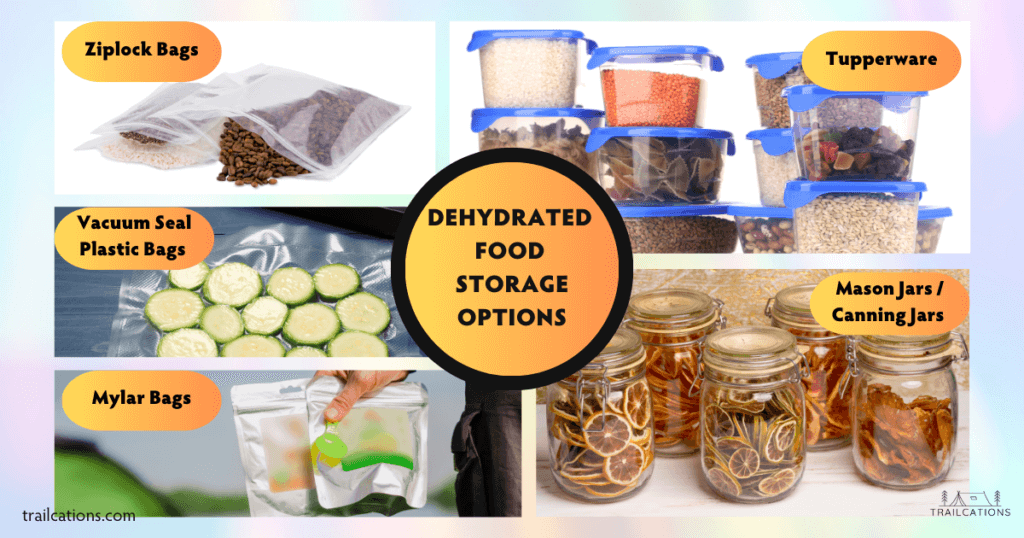
Vacuum Seal Bags
Plastic vacuum seal bags are also excellent options for long term dehydrated food storage if your ingredients are not sharp and pointy. Unfortunately, many dried foods become hard with sharp and pointy edges when dehydrated. Unlike hard-side mason jars, plastic vacuum seal bags can easily when sharp food is vacuum sealed.
To avoid puncturing vacuum seal bags, wrap pointy dried food in a paper towel or parchment paper. Place it in a large enough plastic bag for vacuum sealing. Shaking the food to allow it to lie flat can also help reduce punctures.
Airtight Containers (ex: Tupperware)
Airtight containers like Tupperware are another good option for storing dehydrated food. These containers come in various sizes and shapes and are made from materials like plastic, glass, or metal. They are designed to keep out moisture and air, which can help extend the shelf life of your dehydrated food. However, only the expensive versions can be vacuum sealed so these are best used for short-term dehydrated food storage.
To use airtight containers for dehydrated food storage, simply fill the container with your food. Choose a container that is about the same size as the amount of food you have dehydrated to avoid excess oxygen. Seal the container tightly, adding an oxygen absorber if possible and label it with the contents and date. Store it in a cool, dry place away from direct sunlight.
Ziploc Bags
Plastic zipper top bags are not good for long term storage as they are too permeable to air and moisture. These bags can also leach chemicals into your food if in contact with it for more than a few weeks. Studies have shown that the longer polyethylene (the material Ziploc bags are made from) is in contact with food, the more additives from the manufacturing process leach into food (Hahladakis JN 2018, Zimmerman L 2021, Yang CZ 2011).
We also know about chemicals leaching from zip top style bags into dehydrated food from our unfortunate first-hand experience. Due to the horrible chemical taste and moisture leaking into the bags, I had to throw away many months’ worth (and hundreds of dollars) of dehydrated food on my 6 month thru-hike of the Appalachian Trail.
Ziploc bags are great for storing dehydrated food short term. They make it easy to portion items for upcoming camping trips or healthy snacks at the office. However, avoid storing dehydrated food in zip top style or Ziploc bags long term to preserve your health and food quality.
Food Grade Storage Buckets
Food grade storage buckets are primarily used for storing dehydrated food that has been vacuum sealed in mylar or plastic bags. These large, airtight containers are made with thick plastic compliant to FDA regulations for prolonged food contact. The buckets have robust airtight seals that prevent oxygen, moisture and most importantly pests from contaminating your dried food stores.
These airtight containers offer an extra layer of protection for long-term dehydrated food storage. These durable buckets are easily stackable and the hard-sides prevent light, oxygen, moisture and animals from getting in. Food grade storage buckets are great options for growing your dehydrated food pantry and emergency food storage supplies.
Where to Store Dehydrated Food in Mason Jars
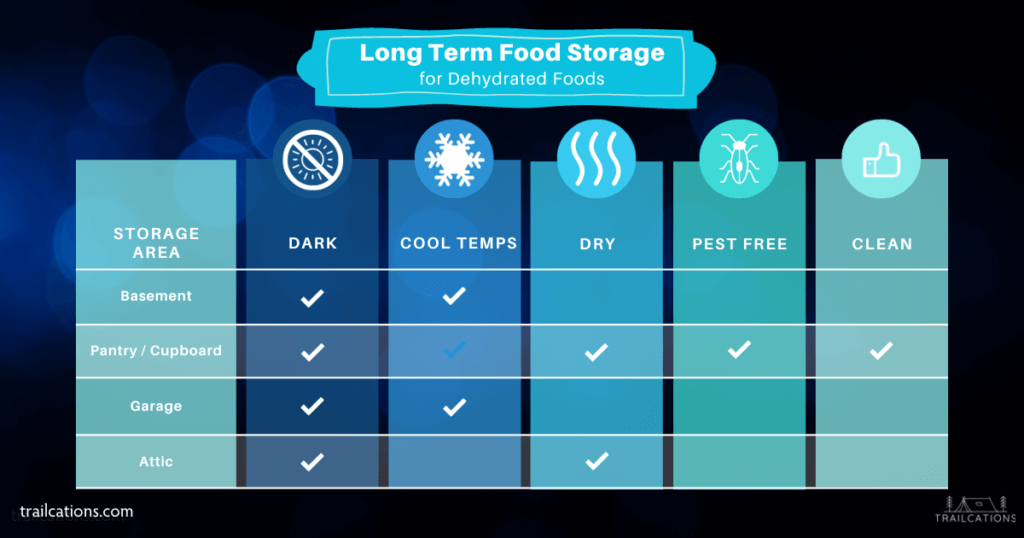
Since mason jars are clear, it is very important to store them away from UV light exposure from the sun. Exposure to sunlight will quickly deteriorate the nutritional value and appearance of the food. Keep the mason jars in an area that isn’t used frequently like a closet, basement or back of the pantry. Some good places to store dehydrated food in mason jars are:
Closet, Pantry or Cupboard
Choose a closet or cupboard that isn’t used frequently to avoid exposing dehydrated food to light. Pantries are a great place to store dehydrated food in mason jars but make sure they’re stored away from light in the back of the pantry or behind other food items.
Basement or Root Cellar
A basement or even better, a root cellar, are good places to store dehydrated food in mason jars. These tend to be dark places away from nutrient-damaging sunlight. However, make sure your basement isn’t too damp that the moisture will spoil the dehydrated food. Opt for placing a humidifier near your dehydrated food and avoid storing it near any pipes where condensation lingers.
Attic
An attic might seem like a good place to store dehydrated food but be wary of seasonal temperature fluctuations. Depending on where you live and if your attic is insulated, it may be too hot during the warmer seasons to safely store your dehydrated food. Keep in mind that shelf life of a dehydrated food is cut in half when you raise storage temperatures to 80°F (27°C) (NCHFP).
Garage
An insulated garage is generally a good place to store dehydrated food if you can keep it off the floor. However, if your garage isn’t well insulated and you live in a hot environment, it’s probably best to store your mason jars of dried food somewhere else. Don’t store dehydrated food in mason jars in a garage port open to the elements and wildlife. It might just grow legs one day when a hungry critter comes strolling by!
Freezer
While dehydrated food is typically meant to be stored at room temperature, you can also store it in the freezer for longer-term storage. To extend dehydrated food shelf life after the USDA recommended storage guidelines, the National Center for Home Food Preservation suggests placing it in the freezer. Freezing cannot preserve food forever but instead slows down the nutrient degradation process.
To store dehydrated food in the freezer, simply place it in an airtight container, vacuum seal bag or mylar bag and seal it tightly. Label the container or bag with the contents and date and place it in the freezer. When you’re ready to use the food, simply thaw it out in the refrigerator and consume within 4 days.
Refrigerator
While not the best option for long-term storage, you can also store dehydrated food in the refrigerator for short periods of time. This can help keep the food fresh and extend its shelf life by a few weeks.
To store dehydrated food in the refrigerator, simply place it in an airtight container or mylar bag and seal it tightly. Label the container or bag with the contents and date and place it in the refrigerator. Make sure to use the food within a few weeks to ensure freshness.
Overall, there are several alternative storage options available for dehydrated food. Choose the option that works best for you based on your storage needs and the length of time you plan to store the food.
How Long Does Dehydrated Food Last in Mason Jars?
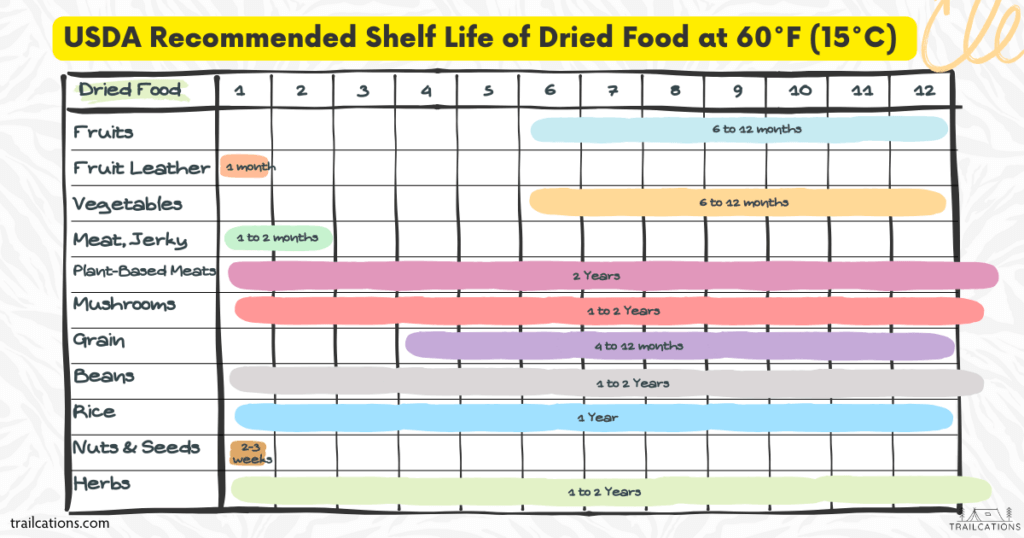
Dehydrated food stored in mason jars lasts for many months or even years. The shelf life depends on the type of food and the environment in which it is stored. Proper storage requires sealing the cleaned, dried mason jars with a vacuum sealer attachment to remove oxygen. For longest shelf life, keep dried food in mason jars away from light, heat, moisture and pests.
The USDA and National Center for Home Food Preservation indicate that when home dehydrated food is prepared, conditioned and stored properly, it should last anywhere between a few months to a few years. After about a year in storage, the nutrient content and appearance of dehydrated food in mason jars does start to deteriorate.
Periodically check your dried food in mason jars for signs of spoilage, moisture or molding. Toss any mason jars that are cracked, chipped or have rusty lids. Damaged mason jars will let in oxygen, moisture and harmful microorganisms.
Vacuum Sealing Dry Food in Mason Jars
Can I Vacuum Seal Dehydrated Food in Mason Jars?
Yes you can absolutely vacuum seal dehydrated food in mason jars. Mason jars can be vacuum sealed to remove oxygen which shortens the shelf life of your dehydrated food. Simply use the jar attachment on your vacuum sealer to remove the air from your mason jars. Alternatively you can use special vacuum port lids and a vacuum hand pump to remove oxygen from a mason jar.
What Do You Need to Vacuum Seal Mason Jars?
You may need to purchase a canning jar adapter which covers the entire flat piece of the lid of the mason jar. This device is critical to use for sealing both regular and wide mouthed mason jars with a vacuum sealer or brake bleeder. You may also need a jar hose attachment to connect the vacuum port on your vacuum sealer to the canning jar adapter.
If you’re using a vacuum sealer, you will need to ensure your appliance has a port for a jar attachment hose. Some inexpensive, basic vacuum sealers may not come with this accessory or port so you may need to pivot to another option of vacuum sealing your mason jars.
If you don’t have a vacuum sealer, you can purchase a special lid kit for mason jars that comes with a portable hand vacuum pump. The portable vacuum pump extracts oxygen from the mason jars using a special vacuum sealing port in the middle of the jar lid. You pull the handle of the pump up to remove the oxygen from the jar.
How Do You Seal Mason Jars for Dehydrated Food? 3 Methods
There are a few methods you can use to create a vacuum in mason jar to store dehydrated food long term.
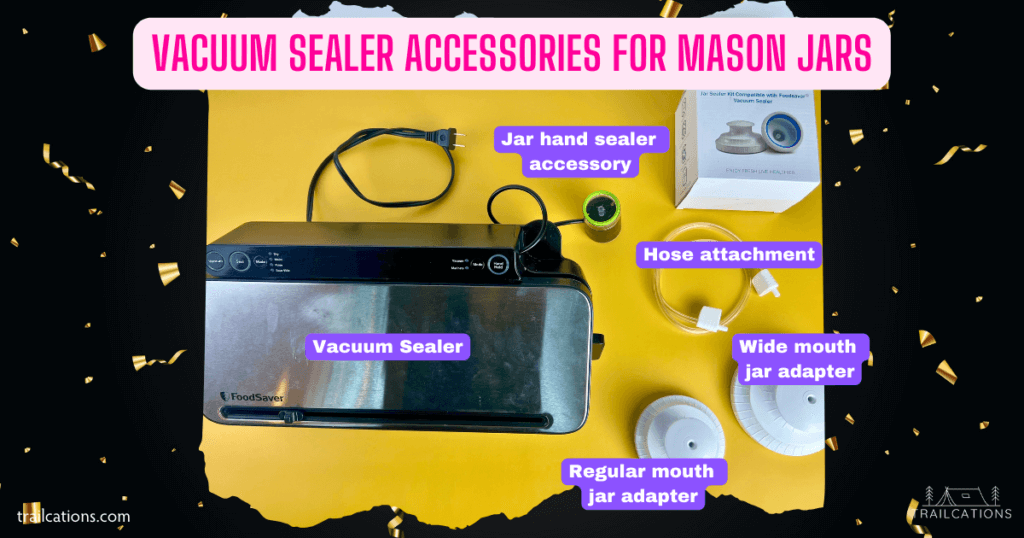
1. Vacuum Sealer Method:
You will need:
- Vacuum sealer appliance with jar attachment hose accessory*
- Canning jar vacuum sealer adapter
- Clean, dry glass mason jar
- Flat metal lid piece (not the screw top ring)
*This will not work on very basic vacuum sealers that do not have a jar attachment hose port.
1. Clean and dry the mason jar and lid.
2. Fill the jar with dehydrated food leaving as little room as possible to reduce oxygen in the jar.
3. Cover the jar with the flat lid piece only. Set the screw top ring aside.
4. Place the jar sealer adapter over the mouth of the jar, on top of the flat lid piece. Make sure to push it down all the way.
5. Insert the hose attachment to the jar sealer adapter. Turn on the vacuum sealer to the jar or accessory mode to create a seal. Let the vacuum sealer run. Once it stops (<30 seconds), shut off the vacuum sealer.
6. Remove the vacuum hose. Next, carefully remove the jar adapter making sure not to break the jar lid seal. Wiggling the jar adapter back and forth or twisting usually helps remove it without breaking the seal.
7. Test the seal to make sure it is intact by using the Press Test, Spoon Test or Concave Test. It’s optional to add the screw top lid to the jar at this point.
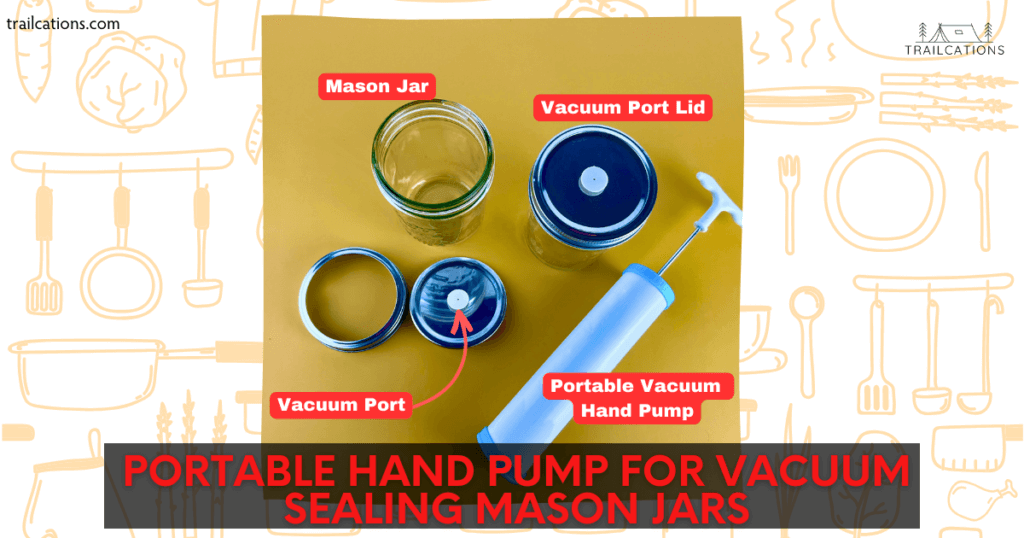
2. Hand Pump Method:
You will need:
- Portable hand pump vacuum sealer (about $20 including 16 special lids)
- Special vacuum seal flat lids with central vacuum port inlet
- Clean, dry glass mason jar
- Screw top lid ring
1. Clean and dry the mason jar and lid. With the special vacuum seal lids, you may need to dry them longer than normal to ensure no water droplets remain in the port.
2. Fill the jar with dehydrated food leaving as little room as possible to reduce oxygen in the jar.
3. Cover the jar with the flat lid piece fitted with the vacuum port inlet.
4. Place the hand pump vacuum sealer flush against the flat lid piece, covering the inlet completely. Pull up on the handle to remove oxygen. You may need to press down firmly on the base of the vacuum pump to hold suction.
5. Pull up as many times as needed on the pump until it is almost impossible to pull up any more. Your jar is now vacuum sealed.
6. Set aside the vacuum pump. Test the seal to make sure it is intact by using the Press Test, Spoon Test or Concave Test. It’s optional to add the screw top lid to the jar at this point.
3. Brake Bleeder Method:
You will need:
- Brake bleeder (less than $20)
- Canning jar vacuum sealer adapter (about $10)
- Clean, dry glass mason jar
- Flat metal lid piece
- Screw top lid ring (optional)
1. Clean and dry the mason jar and lid. With the special vacuum seal lids, you may need to dry them longer than normal to ensure no water droplets remain in the port.
2. Fill the jar with dehydrated food leaving as little room as possible to reduce oxygen in the jar.
3. Cover the jar with the flat lid piece only.
4. Place the jar sealer adapter over the mouth of the jar, on top of the flat lid piece. Make sure to push it down all the way.
5. Insert the brake bleeder hose into the small hole on top of the jar sealer adapter. Pump the brake bleeder until it reaches at least 20 inHg. The higher the reading, the more vacuum.
6. Quickly remove the tip of the brake bleeder from the hole. Next, carefully remove the jar adapter making sure not to break the jar lid seal. Wiggling the jar adapter back and forth or twisting usually helps remove it without breaking the seal.
7. Test the seal to make sure it is intact by using the Press Test, Spoon Test or Concave Test. It’s optional to add the screw top lid to the jar at this point.
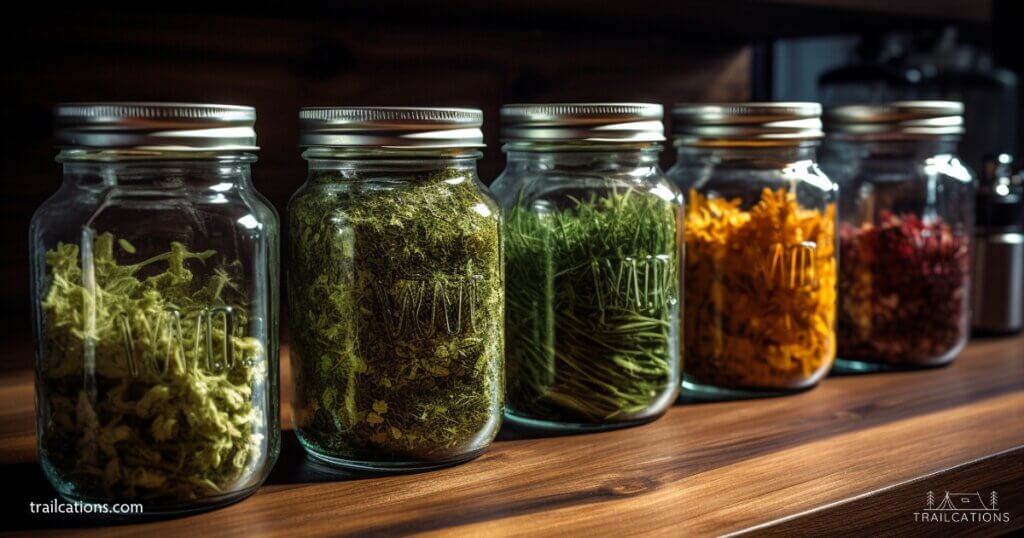
How to Test Canning Jar Seals
Testing canning jar seals is important to ensure that your dehydrated food is safely stored. Here’s how you can test canning jar seals:
1. Fill the jars: After you have finished dehydrating your food, allow the food to cool completely. Pack the dried food tightly inside a clean, dry mason jar.
2. Vacuum seal: Use one of the methods listed above to vacuum seal your mason or canning jar.
3. Test the seal: Gently press down on the center of the lid with your finger or a spoon. If the lid is properly sealed, it should not move or make a popping sound. When tapped with a spoon, a properly sealed lid will sound high-pitched, not dull. The lid may also appear concave, not bulging or flat, depending on which method was used for vacuum sealing.
4. Store or reprocess: If the lid is properly sealed, you can store the jar in a cool, dry, dark place. If the lid is not properly sealed, you can either reprocess the jar or store the dehydrated food in the refrigerator or freezer.
By following these steps, you can ensure that your canning jar seals are properly tested and your food is safely stored.
How Long Does Sealed Dehydrated Food Last in Mason Jars?
Since mason jars are durable airtight containers for dehydrated food storage, the dried food inside will last several months to a year. If the mason jar has been vacuum sealed or has an oxygen absorber inside, the dehydrated food will last towards the longer end of the USDA recommended home dried food shelf life.
Many dehydrating enthusiasts have seen dehydrated food stored in mason jars last longer than the USDA recommended shelf life. We have personally eaten dehydrated fruits, vegetables and grains stored in mason jars that lasted longer than the USDA shelf life. However, we wouldn’t suggest storing dehydrated meats, fish, nuts and seeds in mason jars longer than what is recommended by the USDA.
Here is an interesting article from Chef Glenn at Backpackingchef about what happened to his dehydrated food after storing it for two years in a mason jar (about twice the recommended shelf life).
Oxygen Absorbers vs. Moisture Absorbers in Mason Jars
Oxygen absorbers and moisture absorbers (aka desiccant packs) are NOT necessary for dehydrating and storing food. They are only necessary when you cannot vacuum seal food but need to store it long term. Vacuum sealing removes almost all of the oxygen and ambient moisture out of a jar, just like oxygen and moisture absorbers.
Never use oxygen absorbers in combination with desiccant packs. Oxygen absorbers need moisture to work properly whereas desiccant packs absorb moisture. This makes using them together counterproductive.
Oxygen Absorbers in Mason Jars
If you don’t have access to a vacuum sealer, it’s not a bad idea to throw an oxygen absorber into your mason jar. Oxygen absorbers use iron pellets to absorb almost all of the oxygen in an airtight container. They cost only a few cents per absorber and are excellent to prolong the shelf life of your dehydrated food.
Only use oxygen absorbers in mason jars that won’t be frequently opened. If they’re exposed to the air for about a minute, they will become inactivated and useless.
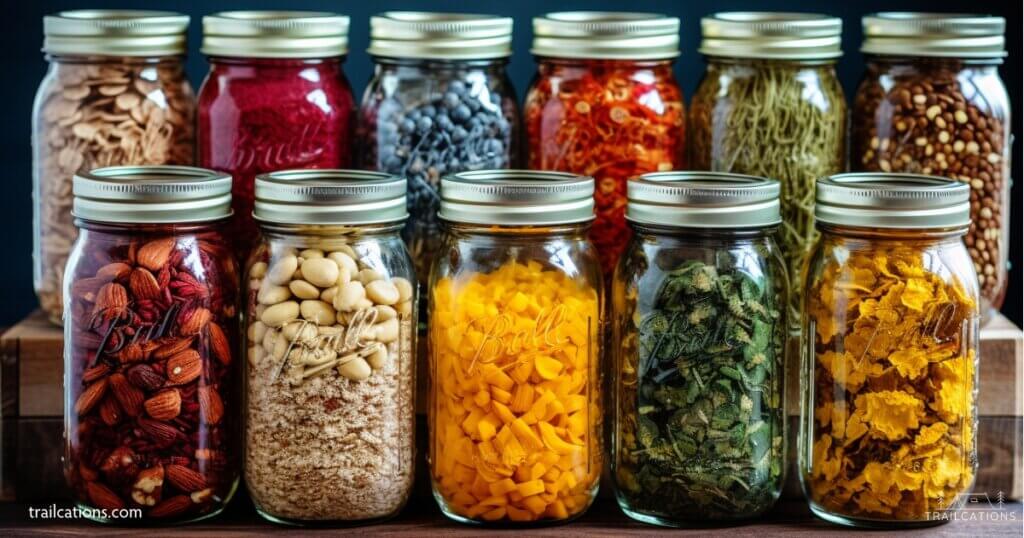
Moisture Absorbers (Desiccant Packs) in Mason Jars
Moisture absorbers aren’t typically used with food – they’re more often seen in dry goods such as shoe boxes, vitamin containers and in electronics boxes. If you do use desiccant packs in your mason jars, make sure you’ve chosen food grade versions. Moisture absorbers are very cheap and rechargeable by drying them out in the oven or dehydrator. However, they are small enough to be choking hazards so be careful.
It is best practice to ensure your dehydrated food is completely dry by testing it for doneness and conditioning it instead of relying on moisture absorbers.
Storing Different Types of Dehydrated Foods
When it comes to storing different types of dehydrated foods in mason jars, there are a few things to keep in mind. By following these tips, you can store a variety of dehydrated foods in mason jars for long-term storage. For a comprehensive list of dehydrated food ideas (and free downloadable PDF), check out 500 Foods You Can and Cannot Dehydrate.
Pro Tip: Remember to label the jars with the date and contents so you can easily keep track of what you have stored. Dried food starts to look very similar, especially when you have a lot in storage!
Here are some tips to help you store various types of dehydrated foods:
Fruits and Vegetables
Dehydrated fruits and vegetables are a great way to enjoy your favorite produce all year round. When storing dehydrated fruits and vegetables in mason jars, make sure the jars are completely clean and dry before filling them. Always condition fruits and vegetables before storing them long term in mason jars. You can use oxygen absorbers or vacuum sealers to remove any excess air from the jars, which can help extend the shelf life of the food.
Meat and Jerky
Dehydrated meat and jerky are popular snacks for hikers and campers, but it can also be a great addition to your pantry. When storing dehydrated meat in mason jars, it’s important to make sure the jerky is completely dry before sealing the jars. You can also add oxygen absorbers to the jars to help prevent spoilage. It might be best to store dehydrated meat and jerky in the freezer or refrigerator for maximum shelf life.
Rice and Grains
Dehydrated rice and grains are a great option for long-term food storage. To store dehydrated grains in mason jars, make sure it is completely dry before filling the jars. You can also add oxygen absorbers to the jars to help keep the rice and grains fresh and prevent clumping.
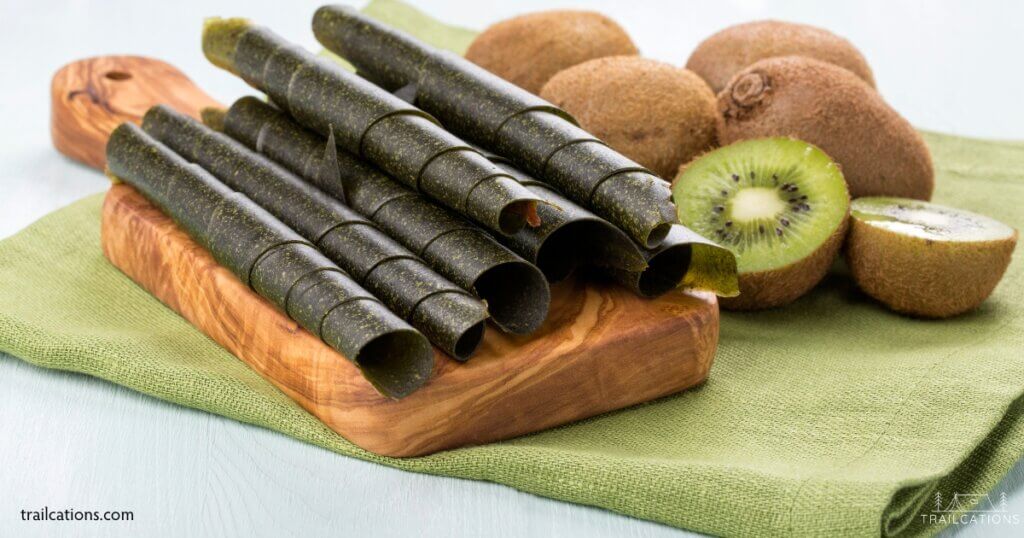
Fruit Leathers
Fruit leathers or fruit rolls are a healthy and delicious snack that can be stored in mason jars for easy access. When storing dried fruit leathers in mason jars, cut the fruit leathers into 1-2 in (2.5-5 cm) strips and roll them up. With sticky fruit leathers, we like to place a scrap of parchment paper between layers before stacking them inside the mason jar. Typically we don’t add oxygen absorbers to the fruit leather mason jars because of their short shelf life and the fact that the they barely last a week because of how quickly we eat them!
Herbs and Spices
Mason jars are excellent for storing dehydrated herbs and spices because they won’t crush or crumble your delicate ingredients. Store dehydrated herbs and spices as intact as possible in mason jars to preserve their delicate essential oils. You can also vacuum seal or add oxygen absorbers to the jars to help keep the herbs fresh.
Baked Goods and Candy
Dehydrated baked goods and candy can be fun and tasty treats. When storing dehydrated baked goods and candy in mason jars, make sure the jars are completely clean and dry before filling them. You can also add oxygen absorbers to the jars to help keep the treats fresh. Mason jars are especially ideal for storing dehydrated baked goods like angel food cake, granola and fruit and nut bars. The hard sided container won’t crumble your baked goods like a vacuum seal bag would.
Dehydrated Food Recipes in a Jar
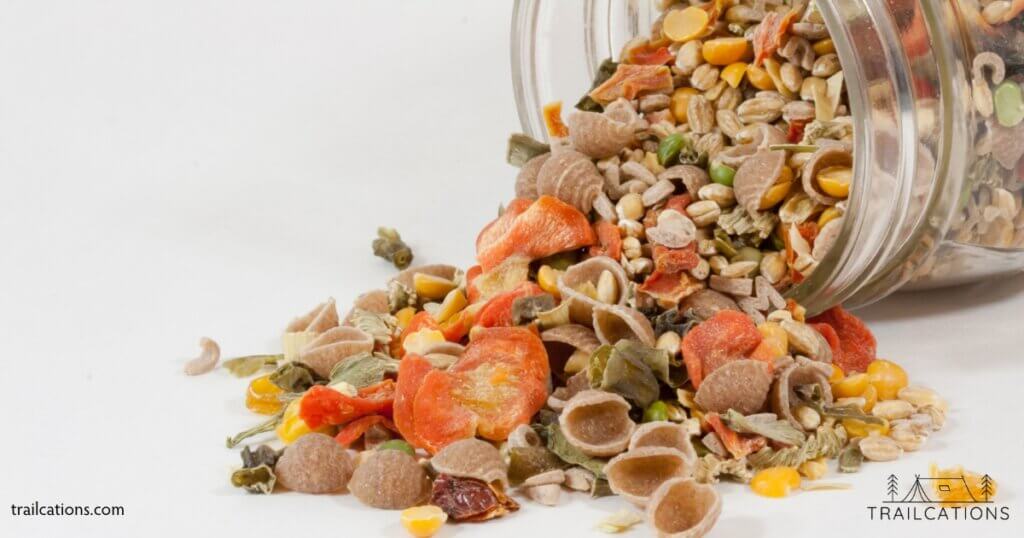
There are so many delicious dehydrated food recipes in a jar that you can create with home dried ingredients. Here are some examples:
1. Soup mixes: You can create your own soup mixes by dehydrating vegetables, beans and grains. Add some spices, homemade flavor powders and bouillon cubes for flavor.
2. Pasta dishes: You can dehydrate cooked pasta, tomato sauce leather and meat or vegetables for a quick and easy meal.
3. Rice dishes: Dehydrated rice can be combined with dehydrated vegetables, sauce leathers and spices for a flavorful meal.
4. Chili: Dehydrated beans, meat or plant-based meat, herbs and vegetables can be combined with chili seasoning for a hearty meal.
5. Oatmeal: Dehydrated oats, nuts, spices and dried fruit can be combined for a quick and healthy breakfast.
6. Trail mix: Dehydrated nuts, seeds and dried fruit can be combined for a healthy snack on the go.
7. Jerky: Dehydrated meat can be marinaded, seasoned and stored for a protein-packed snack.
8. Drink or Cocktail mixes: Dehydrated fruit, spices and herbs can be infused in water, juices or added to wine for creative camping cocktails.
These are just a few examples of the many types of dehydrated meals that can be stored in a jar. With a little creativity, you can create your own custom meals and snacks.
Dry Food Gifts in a Jar

Dry food gifts in a jar are a popular and thoughtful gift idea. Here are some examples of dry food gifts that can be stored in a jar:
1. Cookie mix: Layer the dry ingredients for your favorite cookie recipe in a jar and attach a recipe card.
2. Soup mix: Layer the ingredients for your favorite soup recipe in a jar and attach a recipe card. This is great for vegetarians, vegans and people with food allergies.
3. Hot chocolate mix: Layer cocoa powder, sugar, chocolate chips and mini marshmallows in a jar for a cozy winter treat.
4. Pancake mix: Layer the dry ingredients for your favorite pancake recipe in a jar and attach a recipe card. Include a mini bottle of maple syrup or home dried fruit.
5. Granola: Layer oats, nuts, seeds and dried fruit in a jar for a healthy and delicious breakfast.
6. Spice blends: Mix together your favorite spice blends and store them in a jar for a quick and easy way to add flavor to your meals. This is a great idea for barbecue lovers.
7. Trail mix: Layer nuts, seeds, chocolate candies and dried fruit in a jar for a healthy and portable snack.
8. Mason Jar Cocktails: Layer dried ingredients such as citrus pinwheels, tropical fruit and spices into a mason jar. Add a small bottle of liquor with a recipe card for a thoughtful adult beverage gift.
These are just a few examples of dry food gifts that can be stored in a jar. With a little creativity, you can customize your gifts to suit the tastes of your friends and family.
How to Store Freeze Dried Food in Mason Jars?
Freeze-dried food can be stored in mason jars for long-term storage. The process is the same as storing dehydrated food in mason jars. Here’s how you can store freeze-dried food in mason jars:
1. Clean the jars: Make sure your jars are clean and free of any dirt or debris. Wash them in hot, soapy water and rinse them thoroughly.
2. Dry the jars: Allow the jars to air dry completely or use a clean towel to dry them.
3. Fill the jars: Fill the jars with your freeze-dried food, leaving as little room as possible. More room in the jar means more oxygen which can shorten shelf life.
4. Add an oxygen absorber: Place an oxygen absorber packet in each jar. This will help to remove any excess oxygen from the jar, which can cause the freeze dried food to spoil.
5. Vacuum Seal the jars: Place the flat lid on the jar and use a vacuum sealer, portable vacuum hand pump or brake bleeder to remove oxygen.
6. Label the jars: Label each jar with the date and contents.
7. Store the jars: Store the jars in a cool, dry place away from direct sunlight.
It’s important to note that freeze-dried food can last for decades if stored properly. However, it’s always a good idea to check the food periodically to ensure that it hasn’t spoiled or lost its flavor. By following these steps, you can store your freeze-dried food in mason jars for long-term storage.
Advantages and Disadvantages of Using Mason Jars
When it comes to storing dehydrated food, Mason jars are a popular choice. They offer several advantages and disadvantages that you should consider before using them.
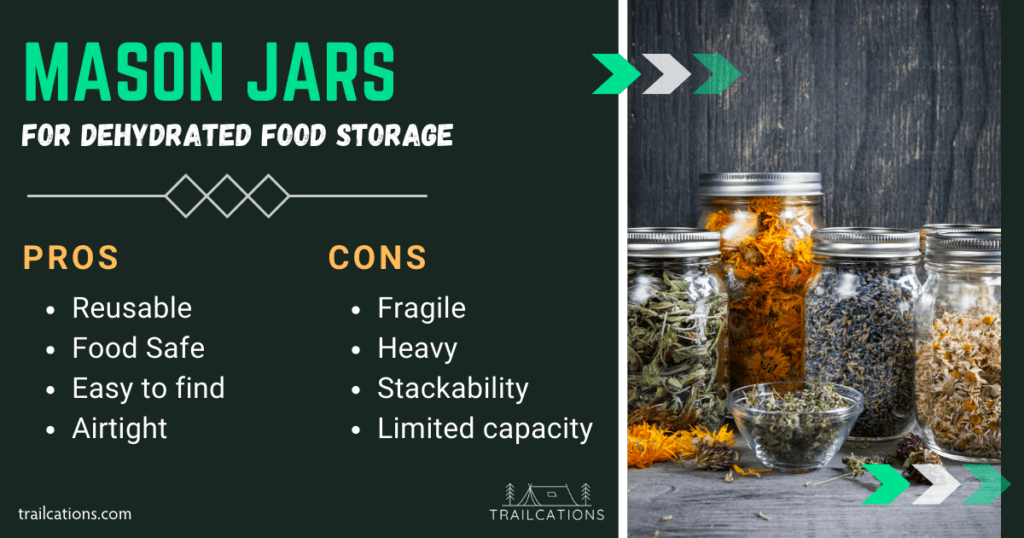
Advantages of Storing Dehydrated Food in Mason Jars
- Reusable: Mason jars are reusable, making them an eco-friendly option for storing dehydrated food. You can use them over and over again without worrying about them breaking down or losing their effectiveness. Throw away any chipped glass jars or rusted lids.
- Food safe: Mason jars are made of glass, which is a non-porous material that does not absorb odors or flavors. This makes them an ideal choice for storing dehydrated food, as it will not affect the taste or quality of the food.
- Easy to find: Mason jars are widely available in many stores, making them easy to find and purchase. They come in a range of sizes, from small to large, so you can choose the right size for your needs. Ask your family for extras or shop around at thrift stores or yard sales for great deals on them.
- Air-tight: Mason jars have airtight lids that seal in the freshness of the food and prevent moisture from getting in. This helps to extend the shelf life of the food and keep it fresh for longer.
Disadvantages of Storing Dehydrated Food in Mason Jars
- Fragile: Mason jars are made of glass, which makes them fragile and prone to breaking. You need to handle them with care to avoid breakage, as broken glass can be dangerous. To be safe, always throw out any dehydrated food that was in a broken mason jar.
- Heavy: Mason jars are heavy, especially when filled with food. This can make them difficult to transport or move around, especially if you have a large quantity of jars. They’re not the best storage container for dehydrated food used for camping, backpacking and hiking.
- Limited capacity: Mason jars come in a range of sizes, but they have a limited capacity compared to other storage containers. This means that you may need to use more jars to store the same amount of food.
- Not stackable: Regular-mouthed mason jars are not stackable due to their tapered shape, which can make them difficult to store in small spaces. You need to have enough shelf space to store them, which may not be practical for everyone. Opt for wide-mouthed jars to increase stackability.
In conclusion, mason jars are a great option for storing dehydrated food, but they do have some disadvantages that you should consider. They are reusable, food safe, easy to find and airtight, but they are also fragile, heavy, have limited capacity and are not always stackable.
Best Glass Jars for Dried Food Storage
The best jar to store dehydrated food in is a glass jar with an airtight seal. Mason jars, canning jars, Ball jars and Kerr jars are a popular choice for storing dehydrated food because they are made of thick, durable glass and have airtight lids that help to keep the food fresh. Mason jars also come in tons of sizes, making them a versatile option for storing different amounts of dehydrated food.
When choosing a jar for storing dehydrated food, it’s important to consider the size of the jar and the amount of food you will be storing. The less oxygen leftover in the jar, the longer the shelf life of your dehydrated food.
You should also make sure that the jar has an airtight seal to prevent air and moisture from entering the jar and spoiling the dried food. Glass containers like old pasta sauce jars, mustard jars and commercial jelly jars aren’t the best options because of their single piece lid. Always opt for two-piece lids with the soft seal on the flat part. The two-piece lid allows for a more robust airtight seal than a single piece lid.
Additionally, glass jars are preferred over plastic containers because they are less likely to retain odors and flavors from previous uses.
Overall, a glass mason jar with an airtight seal is the best option for storing dehydrated food.
Tips for Long Term Storage of Dehydrated Food in Mason Jars
When it comes to storing dehydrated food in mason jars for long-term storage, there are several things you need to keep in mind. Proper storage can help extend the shelf life of your food and ensure that it stays fresh and safe to eat. Here are some tips to help you store your dehydrated food in mason jars for the long term:
Temperature and Environment
One of the most important factors to consider when storing dehydrated food in mason jars is the temperature and environment in which you store them. Ideally, you should store your jars in a cool, dry, dark place with a stable temperature.
Avoid storing them in areas that are subject to fluctuating temperatures, such as near a window or a heating vent. Never store mason jars of dried food in a damp basement or near water pipes due to the heavy moisture levels. 60°F (15°C) is generally considered to be the best temperature for storing dehydrated food in mason jars.
Rotation
Another important consideration when storing dehydrated food in mason jars is rotation. It’s important to rotate your food supply regularly to ensure that you’re using the oldest jars first. This helps prevent waste and ensures that you’re always eating the freshest food possible. To make rotation easier, label your jars with the date you packed them. Use the oldest jars first and replace them with new jars as you use them up.
Labeling
Labeling your jars is also important for long-term storage. Use a label maker, piece of masking tape or a permanent marker to label each jar with the contents and the date you packed it. This helps you keep track of what you have in your pantry and ensures that you’re using the oldest jars first. We suggest also putting the estimated expiration date based on the USDA Food Keeper home dried food guidelines.
Pretreatment for Long Term Storage
Research studies have demonstrated that pretreating fruits and vegetables before dehydrating increases shelf life by destroying bacteria that cause foodborne illness and slowing oxidation.
Food pretreated with an acidic or salt solution are effective at preventing bad bacteria like E. coli, Salmonella and Listeria from growing. Blanching certain vegetables kills off any lingering surface bacteria, mold and yeasts that can contaminate dehydrated food in long term storage.
Conditioning
Conditioning is a final quality check that equalizes the moisture of individual food pieces in a batch of dehydrated food. It reduces the risk of bad bacteria and mold growth in long term storage.
To condition foods, place fruits and vegetables that have cooled and pack them into an airtight glass jar. Clear containers are best for conditioning. Seal the mason jar and let it stand for up to 7 days, checking the food daily for moisture condensation. Gently shake the jars daily to separate the pieces.
If you spot condensation, immediately return the food to the dehydrator for several hours to dry. Recondition the food for up to 7 days, package and store in a cool, dark, dry place.
If there are signs of spoilage like bad smells, mold spots or condensation, you need to throw the entire batch of food away. Unfortunately there is no recovering the spoiled food at this point and you can become very sick if you eat it.
Vacuum Sealing
Vacuum sealing your mason jars can also help extend the shelf life of your dehydrated food. A vacuum sealer removes the air from the jar, which helps prevent oxidation and slows down the growth of bacteria and other microorganisms. This can help your food stay fresh for longer and reduce the risk of spoilage.
Summary
Storing dehydrated food in mason jars for long-term storage requires some planning and attention to detail. By following these tips, you can help ensure that your food stays fresh and safe to eat for as long as possible. Remember to store your jars in a cool, dry place with a stable temperature, rotate your food supply regularly, label your jars, and consider vacuum sealing your jars for even longer shelf life.
Dealing with Potential Issues
Even with the best practices, there are still potential issues that may arise when storing dehydrated food in mason jars. Here are some common issues and how to deal with them:
Spoilage
It is possible for dehydrated food to spoil if not stored properly. Signs of spoilage include mold growth, off smells, condensation and discoloration. If you notice any of these signs, do not consume the food.
To prevent spoilage, make sure to store your dehydrated food in sealed jars in a cool, dry, dark place. Check the jars regularly for any signs of spoilage. It’s also a good idea to label the jars with the date of storage so you know when it’s time to use or discard the food.
What Dehydrated Foods Cannot Be Stored in Mason Jars?
Not all dehydrated food can be stored in mason jars. Some foods, such as those high in oils or fats, can go rancid and spoil quickly. Examples include nuts, seeds and fatty meats. For these foods, it’s best to store them in airtight containers or vacuum seal bags in the refrigerator or freezer.
Why Do Seals Break on Dehydrated Food in Jars?
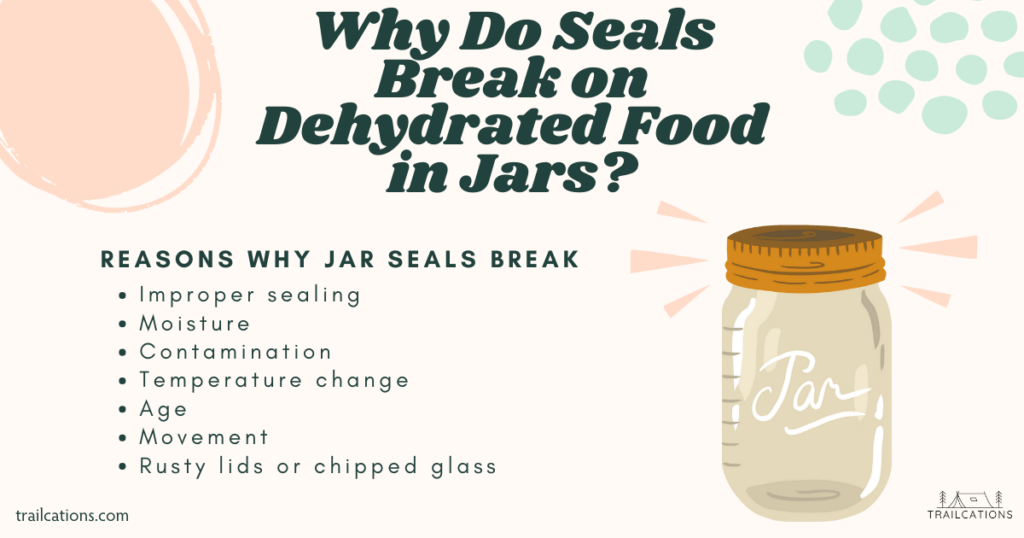
Seals can break on dehydrated food in jars for a few reasons:
1. Improper sealing: If the lid is not tightened enough or the jar is not properly sealed, air can enter the jar and cause the seal to break.
2. Moisture: If the dehydrated food is not completely dry, it can retain moisture and cause the seal to break.
3. Contamination: If the food is contaminated with bacteria or other microorganisms, it can cause the food to spoil and the seal to break.
4. Temperature changes: If the temperature changes rapidly or frequently, it can cause the air inside the jar to expand and contract, which can break the seal.
5. Age: Over time, the seal on the jar can deteriorate and become less effective, which can cause the seal to break.
6. Movement: When moving mason jars of dehydrated food, take care not to bump the containers. Always check the integrity of the seals after transferring jars from one place to another.
7. Rusty lids or chipped glass: A rusted mason jar lid won’t provide a reliable seal. Likewise, damaged glass jars will leak. Throw out any rusty lids and cracked, chipped or broken glass jars.
To prevent seals from breaking on dehydrated food in jars, it’s important to follow proper sealing techniques and ensure that the food is completely dry before storing it. Additionally, store the jars in a cool, dry place away from direct sunlight and avoid exposing them to rapid temperature changes. Finally, check the seals periodically to ensure that they are still intact and the food is still safe to eat.
Best Practices
To ensure the best quality and longest shelf life for your dehydrated food, follow these best practices:
- Use high-quality, airtight mason jars and lids.
- Store the jars in a cool, dry, and dark place away from direct sunlight.
- Label the jars with the food name, dehydration date and estimated expiration date.
- Check the jars regularly for any signs of moisture or spoilage.
- Vacuum seal or add oxygen absorbers to the jars for added protection and longer shelf life.
By following these best practices, you can enjoy your dehydrated food for months or even years to come. Happy Dehydrating and Happy Trailcations Y’all!
Frequently Asked Questions
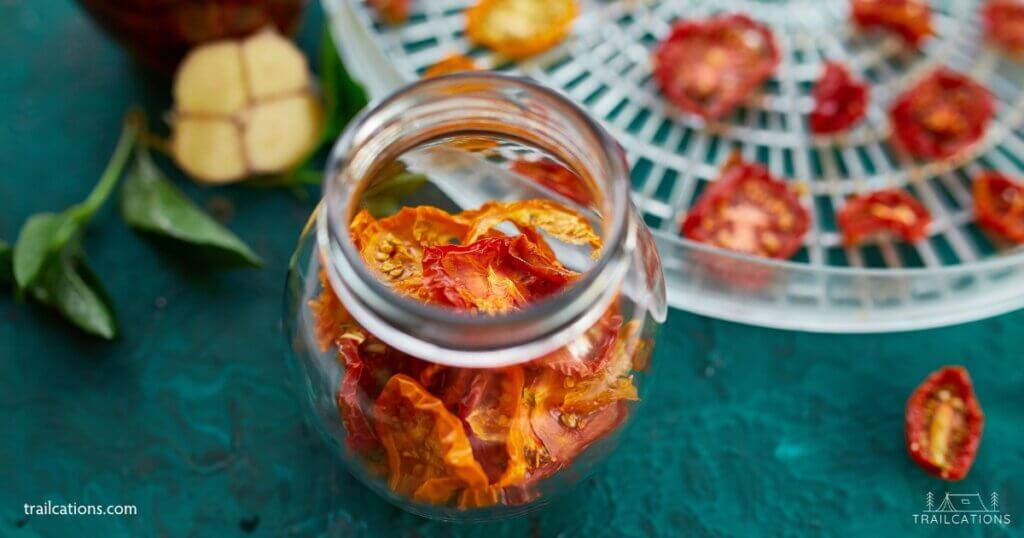
What are the best foods to dehydrate for long-term storage?
Fruits, vegetables, herbs, mushrooms and lean meats are great candidates for dehydration. Some popular fruits include apples, bananas, and strawberries, while vegetables like carrots, green beans, and peppers work well. Herbs like basil, oregano, and thyme can also be dehydrated. Lean meats like beef, chicken and certain types of fish can be dehydrated for long-term storage as well.
How can you store dehydrated food in mason jars without oxygen absorbers?
If you do not have oxygen absorbers, you can still store dehydrated food in mason jars. The key is to ensure that the food is completely dry and that the jars are airtight. You can achieve this by using a vacuum sealer to remove the air from the jar.
What is the best way to store dehydrated food in mason jars long-term?
The best way to store dehydrated food in mason jars long-term is to use oxygen absorbers or vacuum sealing the jar. Oxygen absorbers are small packets designed to remove oxygen from the jar, which helps to prevent spoilage and extend the shelf life of the food. To use them, simply place one or two packets in each jar before sealing it. Vacuum sealers remove almost all of the oxygen from a mason jar, creating an airtight seal and extending shelf life.
Always store dehydrated food in mason jars in a dark, cool, dry place. Since mason jars are clear, food inside is easily depleted of nutrients when exposed to sunlight. A cupboard, closet shelf, root cellar or dark seldom used room are ideal places to store dehydrated food in mason jars long term.
What are the benefits of using oxygen absorbers for dehydrated food storage?
Oxygen absorbers have several benefits for dehydrated food storage. They help to prevent spoilage by removing oxygen from the jar, which slows down the growth of bacteria and other microorganisms. They also help to preserve the color, flavor, and texture of the food by preventing oxidation. Additionally, they can extend the shelf life of the food by several years.
How do you store dehydrated fruit for optimal freshness?
To store dehydrated fruit for optimal freshness, it is important to keep it in a cool, dry place away from direct sunlight. You should also store it in an airtight container, such as a mason jar with an oxygen absorber. If you notice any signs of moisture or mold, you should discard the fruit immediately.
What is the ideal container for storing dehydrated food?
Wide-mouthed mason jars or canning jars are an ideal container for storing dehydrated food because they are airtight, hard-sided and can be easily sealed with a vacuum sealer or oxygen absorber. They are also transparent, which allows you to see the contents of the jar without opening it. Other great options include Mylar bags, plastic vacuum seal bags and airtight Tupperware containers with tight-fitting lids.
Can You Reuse Glass Jars for Dry Food?
Yes, you can reuse glass jars for dry food storage. In fact, reusing glass jars is a great way to reduce waste and save money on storage containers. Here are some tips for reusing glass jars for dry food storage:
1. Clean the jars: Make sure the jars are thoroughly cleaned and free of any food residue. Wash them in hot, soapy water and rinse them thoroughly.
2. Remove labels: If the jars have labels on them, remove them by soaking the jars in warm water and soap. Use a scrubber or scraper to remove any remaining adhesive.
3. Dry the jars and lids: Allow the jars and lids to air dry completely or use a clean towel to dry them.
4. Check for cracks, chips or rust: Inspect the jars for any cracks or chips. If the jars are damaged, they may not be suitable for storage. Check that the lids aren’t rusted.
5. Store dry food: Fill the jars with your dry food. Vacuum seal the jars or use an oxygen absorber to remove excess oxygen.
6. Label the jars: Label each jar with the contents, dehydration date and expiration date.
7. Store the jars: Store mason jars in a cool, dark, dry place away from sunlight. A cupboard, pantry, root cellar or closet shelf are all good options for storage.
Not All Glass Jars are Good for Dry Food Storage
It’s important to note that not all glass jars are suitable for dry food storage. Jars that previously held acidic foods, such as pickles or tomato sauce, may retain a strong odor that can affect the taste of your dry food. Additionally, jars with metal lids may rust over time and compromise the seal. For best results, use glass canning jars such as mason jars, ball jars or Kerr jars with the two piece lids for dry food storage.
Can You Store Dehydrated Fruit in Mason Jars?
Yes, you can store dehydrated fruit in mason jars. In fact, mason jars are a great option for storing dehydrated fruit because they are airtight and can help to keep the fruit fresh for longer. Here’s how you can store dehydrated fruit in mason jars:
1. Clean the jars: Make sure your jars are clean and free of any dirt or debris. Wash them in hot, soapy water and rinse them thoroughly.
2. Dry the jars: Allow the jars to air dry completely or use a clean towel to dry them.
3. Fill the jars: Fill the jars with your dehydrated fruit, leaving as little room as possible to reduce oxygen exposure.
4. Condition the Fruit: Close the jars. For the next 3 to 7 days, shake the jar gently and check daily for signs of moisture. Conditioning equalizes the overall moisture level in the batch of dehydrated fruit. Return the entire batch to the dehydrator if you see any signs of condensation inside the mason jar.
5. Seal the jars for long term storage: Place the lid on the jar and use a vacuum sealer, portable vacuum hand pump or brake bleeder to remove oxygen. Alternatively, place an oxygen absorber inside the jar if a vacuum sealer isn’t available.
6. Label the jars: Label each jar with the dehydration date, estimated expiration date and contents.
7. Store the jars: Store the jars in a cool, dry place away from direct sunlight.
It’s important to note that dehydrated fruit can still spoil if not stored properly. Make sure to check the fruit periodically for any signs of spoilage, such as mold, condensation or an off smell. By following these steps, you can store your dehydrated fruit in mason jars for long-term storage.
Sources
- [1] US Department of Agriculture Research Services Division, Composition of Foods – Handbook No. 8, Analysis Charts Table 2 – Nutrients In The Edible Portion Of One Pound Of Food
- https://nchfp.uga.edu/publications/uga/uga_dry_fruit.pdf
- https://nchfp.uga.edu/how/dry/csu_dry_fruits.pdf
- https://www.foodsafety.gov/keep-food-safe/foodkeeper-app
- https://www.backpackingchef.com/Trail_Bytes-tb-2019-04.html
- https://nchfp.uga.edu/how/dry.html#gsc.tab=0
- https://app.usetopic.com/briefs/5019584c/about%3Ablank
- https://www.sciencedirect.com/science/article/pii/S030438941730763X#bib0355
- https://pubs.acs.org/doi/10.1021/acs.est.1c01103
- https://ehp.niehs.nih.gov/doi/full/10.1289/ehp.1003220?url_ver=Z39.88-2003&rfr_id=ori%3Arid%3Acrossref.org&rfr_dat=cr_pub++0pubmed&
- https://en.wikipedia.org/wiki/Mason_jar